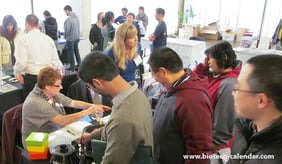In the aftermath of Hurricane Harvey, a group of researchers will study the effects of the pollution stirred up by the flooding. Scientists from Texas A&M, College Station will conduct four environmental research projects thanks to a five year, $10 million grant from the National Institute of Environmental Health Sciences (NIEHS) Superfund Research Program. All four projects will stem from a case study of Galveston Bay and the Houston Ship Channel that examines the chemicals found within the sediment. These studies are designed to improve our understanding of the complexities of hazardous chemicals exposure and its negative impacts on health.
 (Image courtsey of Wikimedia Commons)
(Image courtsey of Wikimedia Commons)
Studying this sediment after the flooding is critical says Dr. Anthony Knap, director of the Geochemical and Environmental Research Group at Texas A&M. He explains in an article for university's news, “There are a hundred years of chemicals in the sediment in the Galveston Bay due to the shallow depth, the proximity to a densely populated area, and concentration of many industries. A hurricane or major storm will dislodge and mobilize many of the legacy chemicals in that sediment and eventually deposit it on land. That creates a completely new contamination and human exposure scenario."
The NEIHS Superfund Research Program is a grant-based program which funds 18 university-based multidisciplinary research teams. These teams study human health and environmental issues specifically related to hazardous chemicals. Their goal is to better understand the link between exposure and disease. The Texas A&M Superfund Research Center is led by Dr. Ivan Rusyn, professor at the university’s College of Veterinary Medicine and Biomedical Sciences and Dr. Anthony Knapp, professor at the College of Geosciences.
When Hurricane Ike caused flooding in Galveston and Houston in 2008, those floodwaters carried sediment from the Houston Ship Channel and Galveston Bay. The problem was officials didn’t know if that sediment was a danger to those being exposed to it. Knap said with Hurricane Ike, "the local and state authorities had to act on general, standard procedures, not the most relevant scientific evidence about this particular event.”
Now nearly a decade later, Hurricane Harvey offers researchers the chance to develop a set of tools for cities, counties, states and federal agencies to use when responding to emergency-related contamination events. These tools will help to mitigate the health and environmental consequences of exposure to hazardous mixtures created during such events. The ultimate goal of the program is to create packages that will serve as “how-tos” for affected areas during any form of environmental emergency situation, from weather-related disasters, to chemical spills, to industrial accidents.
The research projects supported by this research funding will include a study on the transportation and mobilization of complex environmental contaminants in sediment. Another study will seek to develop novel, low cost, broad-acting sorption materials suitable for decreasing exposure to complex chemicals. The third study will establish rapid laboratory tests that will help determine the types of human health and environmental hazards that people might be exposed to. The final study will tackle the challenges of understanding and measuring chemical exposure in order to help first responders and government agencies to make timely and science based decisions.
Researchers Meet with Laboratory Suppiers at Texas A&M, College Station Bioresearch Product Faire:

On Friday January 26, 2018 Biotechnology Calendar, Inc. will host the 17th annual BioResearch Product Faire™ at Texas A&M University. Life science professionals are invited to attend the event for free. Come learn about the latest in laboratory equipement and see demonstations of how these new tools and techniques can assist with your research. For more information about this on campus trade fair and to pre-register click the button below.
This event gives laboratory product and chemical supply companies the opportunity to meet face to face with active researchers and discuss their equipment needs. It allows lab suppliers to display and demonstrate their new products so that scientists can see how they meet their research equipment needs. To participate click the button below:
|
RELATED ARTICLES: Texas A&M: 3D Printed Bone the Future of Facial Surgery Two New Mass Spectrometers Make Texas A&M a Top Facility for Studying Isotopes |



